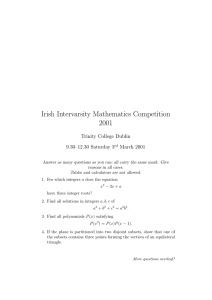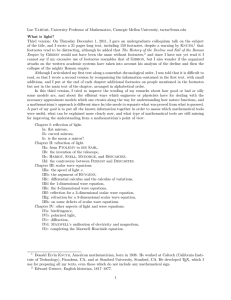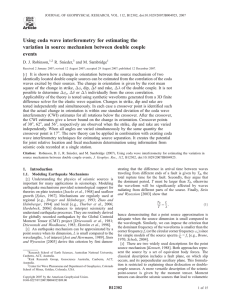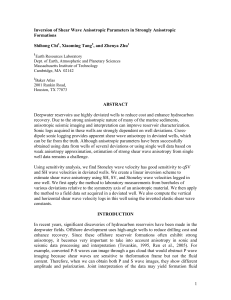∑
advertisement
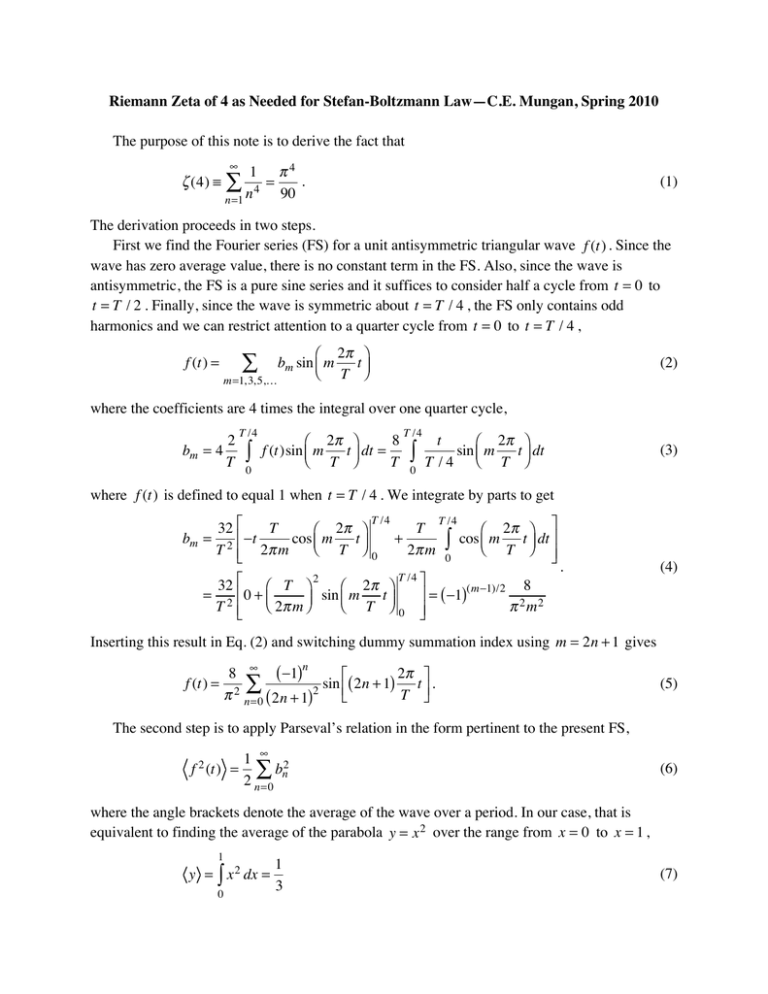
Riemann Zeta of 4 as Needed for Stefan-Boltzmann Law—C.E. Mungan, Spring 2010 The purpose of this note is to derive the fact that ∞ π4 1 ∑ n 4 = 90 . ζ (4) ≡ (1) n=1 The derivation proceeds in two steps. First we find the Fourier series (FS) for a unit antisymmetric triangular wave f (t) . Since the wave has zero average value, there is no constant term in the FS. Also, since the wave is antisymmetric, the FS is a pure sine series and it suffices to consider half a cycle from t = 0 to t = T / 2 . Finally, since the wave is symmetric about t = T / 4 , the FS only contains odd harmonics and we can restrict attention to a quarter cycle from t = 0 to t = T / 4 , f (t) = ⎛ 2π ⎞ bm sin ⎜ m t ⎝ T ⎟⎠ m=1, 3, 5,… ∑ (2) where the coefficients are 4 times the integral over one quarter cycle, bm = 4 2 T T /4 ∫ 0 8 ⎛ 2π ⎞ f (t)sin ⎜ m t ⎟ dt = ⎝ T ⎠ T T /4 ∫ 0 t ⎛ 2π ⎞ sin ⎜ m t ⎟ dt T /4 ⎝ T ⎠ (3) where f (t) is defined to equal 1 when t = T / 4 . We integrate by parts to get 32 ⎡ T ⎛ 2π ⎞ bm = 2 ⎢ −t cos ⎜ m t ⎝ T ⎟⎠ T ⎢ 2π m ⎣ T /4 0 2 32 ⎡ ⎛ T ⎞ ⎛ 2π ⎞ = 2 ⎢0 + ⎜ sin ⎜ m t ⎟ ⎝ 2π m ⎠ ⎝ T ⎟⎠ T ⎢ ⎣ T + 2π m T /4 ⎤ 0 T /4 ∫ 0 ⎛ 2π ⎞ ⎤ cos ⎜ m t dt ⎥ ⎝ T ⎟⎠ ⎥ ⎦ ⎥ = ( −1) ⎥⎦ (m−1)/2 . (4) 8 π 2 m2 Inserting this result in Eq. (2) and switching dummy summation index using m = 2n + 1 gives 8 ∞ ( −1) 2π ⎤ ⎡ f (t) = 2 ∑ sin ⎢( 2n + 1) t ⎥ . 2 π n=0 ( 2n + 1) T ⎦ ⎣ n (5) The second step is to apply Parseval’s relation in the form pertinent to the present FS, f 2 (t) 1 ∞ 2 = ∑ bn 2 n=0 (6) where the angle brackets denote the average of the wave over a period. In our case, that is equivalent to finding the average of the parabola y = x 2 over the range from x = 0 to x = 1 , 1 y = ∫ x 2 dx = 0 1 3 (7) since our triangular wave amounts to a linear ramp from zero up to unity over a quarter cycle. Substituting this result into the left-hand side of Eq. (6) and the coefficients from Eq. (5) into the right-hand side, we have 1 1 64 ∞ 1 = ∑ 4 3 2 π n=0 ( 2n + 1)4 ⇒ ∞ ∑ n=0 1 ( 2n + 1)4 = π4 . 96 (8) Finally we equate this sum over only odd integers to the desired sum over all integers minus the sum over only even integers, ∞ ∞ ∞ π4 1 1 1 15 ∞ 1 =∑ =∑ −∑ = ∑ 96 n=0 ( 2n + 1)4 n=1 n 4 n=1 ( 2n )4 16 n=1 n 4 where the last equality came from factoring 1 / 2 4 = 1 / 16 out of the sum over even integers. Rearranging Eq. (9) now gives Eq. (1). (9)
